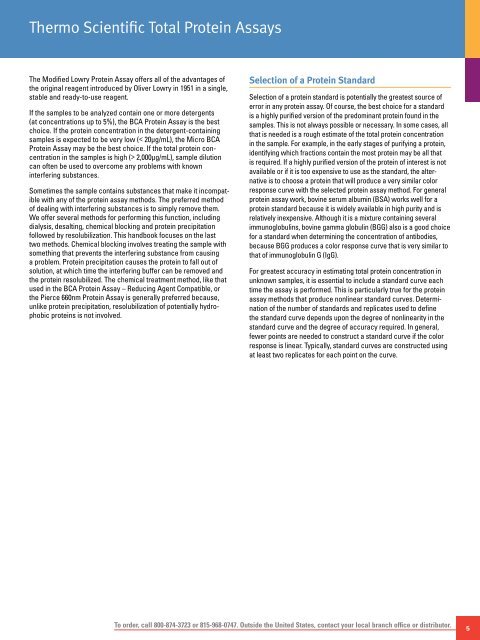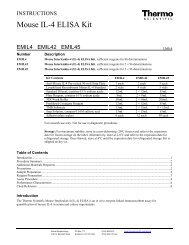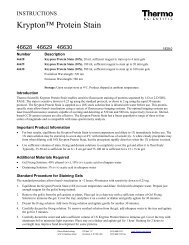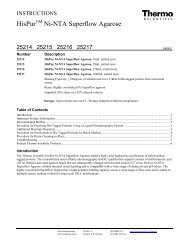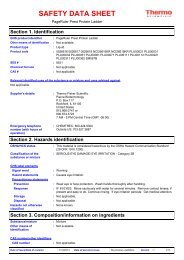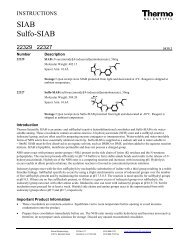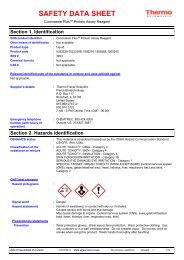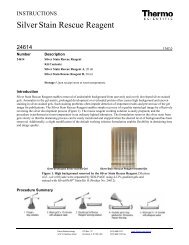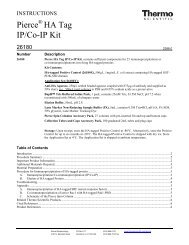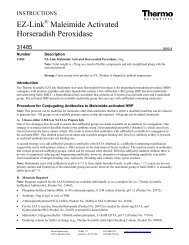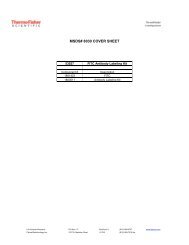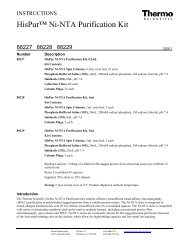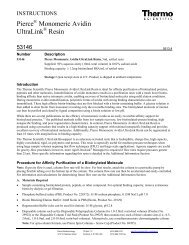Thermo Scientific Pierce Protein Assay Technical Handbook Version 2
Thermo Scientific Pierce Protein Assay Technical Handbook Version 2
Thermo Scientific Pierce Protein Assay Technical Handbook Version 2
You also want an ePaper? Increase the reach of your titles
YUMPU automatically turns print PDFs into web optimized ePapers that Google loves.
<strong>Thermo</strong> <strong>Scientific</strong> Total <strong>Protein</strong> <strong>Assay</strong>s<br />
The Modified Lowry <strong>Protein</strong> <strong>Assay</strong> offers all of the advantages of<br />
the original reagent introduced by Oliver Lowry in 1951 in a single,<br />
stable and ready-to-use reagent.<br />
If the samples to be analyzed contain one or more detergents<br />
(at concentrations up to 5%), the BCA <strong>Protein</strong> <strong>Assay</strong> is the best<br />
choice. If the protein concentration in the detergent-containing<br />
samples is expected to be very low (< 20µg/mL), the Micro BCA<br />
<strong>Protein</strong> <strong>Assay</strong> may be the best choice. If the total protein concentration<br />
in the samples is high (> 2,000µg/mL), sample dilution<br />
can often be used to overcome any problems with known<br />
interfering substances.<br />
Sometimes the sample contains substances that make it incompatible<br />
with any of the protein assay methods. The preferred method<br />
of dealing with interfering substances is to simply remove them.<br />
We offer several methods for performing this function, including<br />
dialysis, desalting, chemical blocking and protein precipitation<br />
followed by resolubilization. This handbook focuses on the last<br />
two methods. Chemical blocking involves treating the sample with<br />
something that prevents the interfering substance from causing<br />
a problem. <strong>Protein</strong> precipitation causes the protein to fall out of<br />
solution, at which time the interfering buffer can be removed and<br />
the protein resolubilized. The chemical treatment method, like that<br />
used in the BCA <strong>Protein</strong> <strong>Assay</strong> – Reducing Agent Compatible, or<br />
the <strong>Pierce</strong> 660nm <strong>Protein</strong> <strong>Assay</strong> is generally preferred because,<br />
unlike protein precipitation, resolubilization of potentially hydrophobic<br />
proteins is not involved.<br />
Selection of a <strong>Protein</strong> Standard<br />
Selection of a protein standard is potentially the greatest source of<br />
error in any protein assay. Of course, the best choice for a standard<br />
is a highly purified version of the predominant protein found in the<br />
samples. This is not always possible or necessary. In some cases, all<br />
that is needed is a rough estimate of the total protein concentration<br />
in the sample. For example, in the early stages of purifying a protein,<br />
identifying which fractions contain the most protein may be all that<br />
is required. If a highly purified version of the protein of interest is not<br />
available or if it is too expensive to use as the standard, the alternative<br />
is to choose a protein that will produce a very similar color<br />
response curve with the selected protein assay method. For general<br />
protein assay work, bovine serum albumin (BSA) works well for a<br />
protein standard because it is widely available in high purity and is<br />
relatively inexpensive. Although it is a mixture containing several<br />
immunoglobulins, bovine gamma globulin (BGG) also is a good choice<br />
for a standard when determining the concentration of antibodies,<br />
because BGG produces a color response curve that is very similar to<br />
that of immunoglobulin G (IgG).<br />
For greatest accuracy in estimating total protein concentration in<br />
unknown samples, it is essential to include a standard curve each<br />
time the assay is performed. This is particularly true for the protein<br />
assay methods that produce nonlinear standard curves. Determination<br />
of the number of standards and replicates used to define<br />
the standard curve depends upon the degree of nonlinearity in the<br />
standard curve and the degree of accuracy required. In general,<br />
fewer points are needed to construct a standard curve if the color<br />
response is linear. Typically, standard curves are constructed using<br />
at least two replicates for each point on the curve.<br />
To order, call 800-874-3723 or 815-968-0747. Outside the United States, contact your local branch office or distributor.<br />
5


